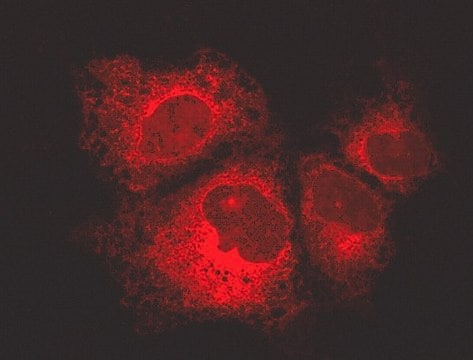おすすめの製品
メーカー/製品名
Chemicon®
LentiBrite
品質水準
テクニック
cell based assay: suitable
immunocytochemistry: suitable
immunofluorescence: suitable
transfection: suitable
UniProtアクセッション番号
検出方法
fluorometric
輸送温度
dry ice
遺伝子情報
human ... SQSTM1(8878)
関連するカテゴリー
詳細
http://www.nature.com/app_notes/nmeth/2012/121007/pdf/an8620.pdf
(Click Here!)
Learn more about the advantages of our LentiBrite Lentiviral Biosensors! Click Here
Biosensors can be used to detect the presence/absence of a particular protein as well as the subcellular location of that protein within the live state of a cell. Fluorescent tags are often desired as a means to visualize the protein of interest within a cell by either fluorescent microscopy or time-lapse video capture. Visualizing live cells without disruption allows researchers to observe cellular conditions in real time.
Lentiviral vector systems are a popular research tool used to introduce gene products into cells. Lentiviral transfection has advantages over non-viral methods such as chemical-based transfection including higher-efficiency transfection of dividing and non-dividing cells, long-term stable expression of the transgene, and low immunogenicity.
EMD Millipore is introducing LentiBrite Lentiviral Biosensors, a new suite of pre-packaged lentiviral particles encoding important and foundational proteins of autophagy, apoptosis, and cell structure for visualization under different cell/disease states in live cell and in vitro analysis.
- Pre-packaged, fluorescently-tagged with GFP & RFP
- Higher efficiency transfection as compared to traditional chemical-based and other non-viral-based transfection methods
- Ability to transfect dividing, non-dividing, and difficult-to-transfect cell types, such as primary cells or stem cells
- Non-disruptive towards cellular function
EMD Millipore’s LentiBrite GFP-p62 lentiviral particles provide bright fluorescence and precise localization to enable live-cell analysis of autophagy in difficult-to-transfect cell types.
アプリケーション
アポトーシス及び癌
ニューロサイエンス
アポトーシス-追加
神経変性疾患
Imaging:
(See Figure 1 in datasheet)
Primary human mesenchymal stem cells (HuMSC) were plated in a chamber slide and transduced with lentiviral particles at an MOI of 40 for 24 hours. After media replacement and 24 hours further incubation, cells were either left in complete media or incubated for 4 hours in EBSS containing a lysosome inhibitor, to induce autophagsome formation and inhibit lysosomal degradation. Cells were fixed with formaldehyde, mounted and imaged by oil immersion wide-field fluorescence microscopy.
The GFP-p62 displays a diffuse cytosolic distribution in fed cells, and a punctate distribution in starved autophagic cells.
Immunocytochemistry Comparison:
(See Figure 2 in datasheet)
Similar to Figure 1 (see datasheet), U2OS cells were plated in a chamber slide and transduced with GFP-p62 lentiviral particles at an MOI of 40 for 24 hours. After 24 hours, media was replaced and cells were then further incubated for 24 hours. The cells were then fixed and stained with a polyclonal antibody against p62 (Cat. No. MABC32), followed by a Cy3-conjugated anti-rabbit IgG. Distribution of the GFP-p62 (green) is similar to that detected by immunocytochemical staining (red).
Hard-to-transfect Cell Types:
(See Figure 3 in datasheet)
Primary cell type HUVEC were plated in a chamber slide and transduced with lentiviral particles at an MOI of 40 for 24 hours. Subsequent treatments for cells left in complete media or cells incubated in EBSS with lysosome inhibitor, were performed as in Figures 1A and 1B (see datasheet)
Time-lapse Imaging:
(See Figure 5 in datasheet and video online)
U2OS cells were plated in coverglass chamber slides and transduced with GFP-p62 lentiviral particles as in Figure 1 (see datasheet). Images were collected every 20 seconds for a total of 32 min. Shown here are 3 sequential frames. The GFP-p62 displays a diffuse cytosolic distribution in fed cells, and a punctate distribution in starved autophagic cells.
For optimal fluorescent visualization, it is recommended to analyze the target expression level within 24-48 hrs after transfection/infection for optimal live cell analysis, as fluorescent intensity may dim over time, especially in difficult-to-transfect cell lines. Infected cells may be frozen down after successful transfection/infection and thawed in culture to retain positive fluorescent expression beyond 24-48 hrs. Length and intensity of fluorescent expression varies between cell lines. Higher MOIs may be required for difficult-to-transfect cell lines.
構成
One vial containing 25 µL of lentiviral particles at a minimum of 3 x 10E8 infectious units (IFU) per mL.
For lot-specific titer information, please see lot specific “Viral Titer” in the product specifications of the datasheet.
Promoter
EF-1 (Elongation Factor-1)
Multiplicty of Infection (MOI)
MOI = Ratio of # of infectious lentiviral particles (IFU) to # of cells being infected.
Typical MOI values for high transduction efficiency and signal intensity are in the range of 20-40. For this target, some cell types may require lower MOIs (e.g., HT-1080, HeLa, U2OS, human mesenchymal stem cells (HuMSC)), while others may require higher MOIs (e.g., human umbilical vein endothelial cells (HUVEC)).
NOTE: MOI should be titrated and optimized by the end user for each cell type and lentiviral target to achieve desired transduction efficiency and signal intensity.
品質
物理的形状
保管および安定性
Lentivirus is stable for at least 4 months from date of receipt when stored at -80°C. After first thaw, place immediately on ice and freeze in working aliquots at -80°C. Frozen aliquots may be stored for at least 2 months. Further freeze/thaws may result in decreased virus titer and transduction efficiency.
IMPORTANT SAFETY NOTE
Replication-defective lentiviral vectors, such as the 3rd Generation vector provided in this product, are not known to cause any diseases in humans or animals. However, lentiviruses can integrate into the host cell genome and thus pose some risk of insertional mutagenesis. Material is a Risk Group 2 and should be handled under BSL2 controls. A detailed discussion of biosafety of lentiviral vectors is provided in Pauwels, K. et al. (2009). State-of-the-art lentiviral vectors for research use: Risk assessment and biosafety recommendations. Curr. Gene Ther. 9: 459-474.
法的情報
保管分類コード
10 - Combustible liquids
WGK
WGK 2
適用法令
試験研究用途を考慮した関連法令を主に挙げております。化学物質以外については、一部の情報のみ提供しています。 製品を安全かつ合法的に使用することは、使用者の義務です。最新情報により修正される場合があります。WEBの反映には時間を要することがあるため、適宜SDSをご参照ください。
Jan Code
17-10224:
試験成績書(COA)
製品のロット番号・バッチ番号を入力して、試験成績書(COA) を検索できます。ロット番号・バッチ番号は、製品ラベルに「Lot」または「Batch」に続いて記載されています。
資料
Cell based autophagy assays including live cell LC3 GFP/RFP lentiviral biosensors, kits for autophagy detection and autophagy activators and inhibitors.
関連コンテンツ
Fluorescent lentiviral particles encoding important GFP/RFP fusion proteins related to autophagy, apoptosis, and cell structure that enables live cell imaging.
ライフサイエンス、有機合成、材料科学、クロマトグラフィー、分析など、あらゆる分野の研究に経験のあるメンバーがおります。.
製品に関するお問い合わせはこちら(テクニカルサービス)








